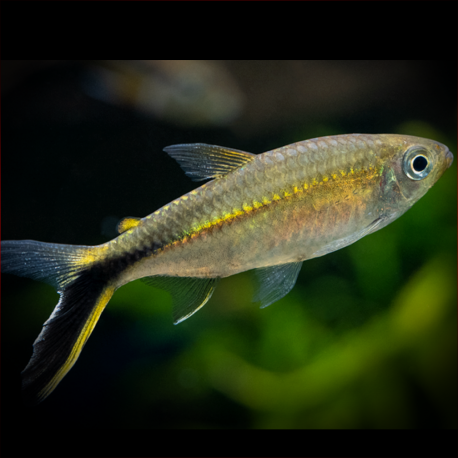More info
Datasheet
| Minimum Tank Size | 70 litres / 18.49 US gallons |
| Maximum Size | 8.1cm / 3.19inches |
| Temperature | 22°C / 71.60°F - 28°C / 82.40°F |
| Hardness | 0-15ºdH |
| pH | 6.0-7.0 |
General Description
Thayeria Obliqua, commonly known as the Penguin Tetra, is a peaceful species within the Characidae family, originating from the central Amazon and Rio Tocantins basins and the Rio Guaporé in Brazil. This species typically grows to a maximum size of 8.1cm and is recognized for its distinct oblique swimming style observed in all Thayeria species. The taxonomic classification of Thayeria species is currently uncertain, calling for a comprehensive revision to potentially reclassify these species into new or different genera.
Aquarium Setup
For optimal care, Penguin Tetras thrive in a well-maintained community aquarium with South American species like Hemigrammus or Hyphessobrycon tetras, pencil fish, Apistogramma, small cichlids, Corydoras, and Loricariids. It is recommended to keep a group of at least 6 individuals, preferably 10 or more, as they are schooling fish that display enhanced behaviors and reduced fin-nipping tendencies in larger numbers. Penguin Tetras are well-suited for heavily planted tanks with a dark substrate and may benefit from the addition of floating plants to simulate their preferred shady conditions.
Behaviour
Penguin Tetras exhibit peaceful behavior but may not thrive alongside highly boisterous or significantly larger tankmates. Maintaining them in schools enhances their well-being, diminishes aggressive interactions, and presents a visually appealing aquarium. In a suitable community setup, these tetras can coexist harmoniously with smaller rasboras, barbs, Anabantoids, and West African dwarf cichlids such as Pelvicachromis species.
Feeding and Diet
In their natural habitat, Penguin Tetras likely feed on small insects, worms, crustaceans, and zooplankton. Maintaining their vibrancy and health involves providing a varied diet that includes small live and frozen foods such as bloodworms, Daphnia, and Artemia, supplemented with dried flakes and granules to ensure balanced nutrition.
Reproduction & Dimorphism
Although there is limited information on captive breeding of Penguin Tetras, their reproductive strategy likely mirrors that of similar species like T. boehlkei. Adult females can be distinguished by their rounder bellies and slightly subdued coloration compared to males.
Habitat and Distribution
In their natural environment, Penguin Tetras inhabit jungle streams and tributaries characterized by dense marginal vegetation in the central Amazon and Rio Tocantins basins, as well as the Rio Guaporé in Brazil. Maintaining water conditions with a hardness of 0-15°dH, a pH range of 6.0-7.0, and temperatures between 22-28°C closely mimics their native habitats.

